By Jake Adams
There is something very exciting about catching that fleeting moment when pelagic spawning reef fish release their gametes. Catching the act of pelagic spawning is very much like seeing a shooting star: you sometimes know when the event is about to happen, but if you look away for a few seconds you could miss it. Having been a marine aquarist for about 15 years, I can remember a time when getting reef fish to spawn was quite an accomplishment. It was hard enough getting one specimen of a reef fish species to live in an aquarium let alone getting two specimens to thrive and pair off to result in spawning. Egg-laying clownfish and damselfish and mouth brooding cardinalfish have long been the exception as these species are relatively hardy and pairing off a couple specimens of these species is relatively straightforward. Furthermore, whereas egg-layers and mouthbrooders have a protracted spawning duration, broadcast spawners have more elaborate courtship displays that culminate in a release of egg and sperm that usually only last but a few seconds. In order to witness pelagic spawning reef fish, you have to be aware of fish behavior, timing and many different cues to get the signal that reef fish are about to spawn. Once a likely spawning pair has been identified you still have to wait anxiously for tens of minutes, sometimes up to an hour until the final act where egg and sperm are simultaneously released. Needless to say, catching reef fish in the act of spawning takes some effort and a little luck, but every occasion of pelagic spawning is likely to be very memorable.

Having a harem of fish consisting of a male and several females will increase your chances of catching a male and female in the act of pelagic spawning.
There are five groups of commonly kept reef fish which are pelagic spawners and that are likely to be kept in aquaria as pairs: Angelfish, Tangs, Wrasses, Dragonets and Anthias. I have personally observed numerous aquarium spawning events of all of these except for Anthias, so I will be omitting discussing the habits of the Anthias group. With a large enough tank just about any pelagic spawning fish could be induced to spawn, but those four groups are the most frequently observed pelagic spawners because they are such popular fish for reef aquariums that they are most likely to be kept in pairs. Furthermore, angels, tangs, wrasses and dragonets all include many members that spawn well within the confines of smaller aquariums; pygmy angels and scooter blennies can get their groove on in aquariums as small as 30 gallons. If you want to watch pelagic spawning in reef fish, there are a few things you can do to help set the mood. Besides having a viable pair that is sexually mature, twilighting, good conditioning and the proper stable environment all can help to trigger more frequent and regular spawning.
For years the reefing hobby was trapped into thinking that moonlighting was necessary to encourage pelagic spawning. Although the reduced lighting did encourage certain reef fish to spawn, moonlighting a reef was thought to be most effective at inducing spawning when it simulated a lunar cycle. A lunar cycle of moon lighting is certainly an important factor for getting corals to spawn, but captive pelagic spawning reef fish can spawn almost every night under the right conditions, for months at a time. Of all the pelagic spawnings I have witnessed in aquaria, none of them had any kind of moonlighting, let alone one with a lunar simulator. Furthermore, if pelagic spawners are given an all-night moonlight period, their regular spawning time is likely to run into the night, perhaps past the bedtime of many potential observers. What is important for the timing of pelagic spawning is twilighting, or any kind of reduced lighting period that precedes the mostly dark night period. The twilight period can be as simple as having some of the aquarium lights begin to go out, or it can be provided by a dedicated light of moderate intensity. Having a twilight period to encourage pelagic spawning should be at least an hour long to give the a spawning pair ample time to go through the motions, but once the fish synchronize with the lights they may do their thing within a much narrower window of time. If the timing of the lights is consistent, then the timing of the spawns will also be at a regular time.
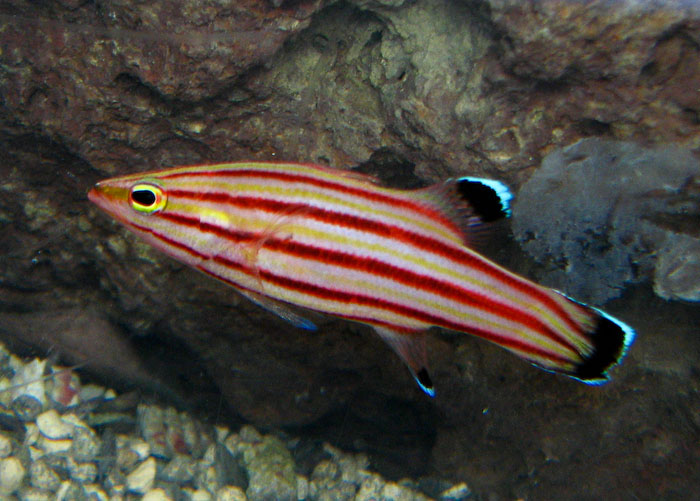
Liopropoma basslets such as this swissguard basslet spawn only in very dark conditions, you’ll be hard pressed to watch them get it on unless you have night vision equipment.
The process of producing gametes for reproduction is one that requires a lot of nutrients and energy regardless of what kind of animal you are. You cannot expect a skinny fish to do much more than seek out food and by that same note, a well fed and round reef fish is that much more likely to be in breeding shape. Male fish don’t require much encouragement to be in breeding condition, but female fish have to produce energy rich eggs. Like my Zoology professor used to say, “sperm is cheap, but eggs are expensive”. The production of eggs in pelagic spawning reef aquarium fish takes days or weeks and you are much more likely to get spawning after successive days of feeding rich food. Furthermore, foods with a high concentration of good quality protein and a high fat content will not only help with the production of viable eggs, but it can also trigger spawning. I once watched flame wrasse spawning for almost a month and the spawning courtship and egg release did not begin until after the second feeding of the day; if the second feeding was withheld the male flame wrasse would do his courtship routine, but the females in the harem would all but ignore his romantic advances. Needless to say, generous feedings of high quality food can act as one of the triggers to induce a spawning event.
It is common knowledge that in the wild, pelagic spawning reef fish can use up a lot of vertical space while doing their spawning ascents. Reef fish that are learning to spawn in the restricted space of captivity can mostly make do with an abbreviated vertical space, but mileage varies between species and groups. I have seen red scooter blennies, Synchiropus stellatus, spawn in tanks as shallow as 10 inches deep whereas the female half of a Paracheilinus flavianalis, yellow fin flasher wrasse pair struggled to do her thing in a 24” deep tank. However, in the latter case the reefscape was built up to within six inches of the water surface, evidence that the depth of the tank and vertical height above the reef structure are two different things to pelagic spawning reef fish. Part of the breeding strategy of pelagic spawning reef fish is to release their gametes away from the reef where innumerable filter feeders live solely to capture high quality food particles like fish eggs. If the female invests a significant amount of energy and resources to producing eggs she will not be comfortable releasing the precious gametes right into the mouths of the reef.
If you have a reef tank and you like your fish, you should become familiar with their normal daytime behavior: swimming around at a normal pace, grazing or picking on surfaces of the glass or rocks and most of all, begging for food. If you have pairs of a certain species, and it is later in the day or evening and your fish aren’t exhibiting most of the normal daytime tendencies, chances are they are warming up for their spawning ritual with the fish equivalent of foreplay– courtship. The male of reef fish species mainly initiates courtship, and in many cases the courtship resembles a more excited version of normal daytime activities like chasing the females and showing off. Male flasher and fairy wrasses practically wear a neon sign advertising their readiness to spawn with gaudy coloration, elaborate finnage and energetic nuptial displays. The signs of courtship are subtler in other fish groups, but it generally involves a lot of interaction between two fish, with one fish taking the lead displaying to the other with fervor, nudging near the **** fin and or constant following around the tank.
If you are looking at a pair of reef fish that are preparing to spawn, the first sign is that they will be high in the water column, much higher than they would typically be during the daytime. As spawning gets closer the bodies of the two fish will be very close, there will be a lot of touching between their pectoral fins and there may be some degree of temporary synchronization of their movements. The synchronization is important because it allows the fish to gauge the position of their partner so that they can orient their bodies in a way that allows maximum mixing between the eggs and sperm, resulting in higher fertility rates. Just prior to egg and sperm release the two fish will touch the lower parts of their bodies for a few seconds while they ascend higher in the water column and with a little shimmying of their bodies the fish time the actual release of gametes. Many fish will then dart quickly apart and with a flick of their tail they disperse the eggs into the water column. And that’s it! After a long period of anticipation it may take a few moments to realize what you have just seen. However, if you catch a small patch of cloudy water between a pair of fish high in the water column during twilight there is no question that you have just witnessed pelagic spawning.
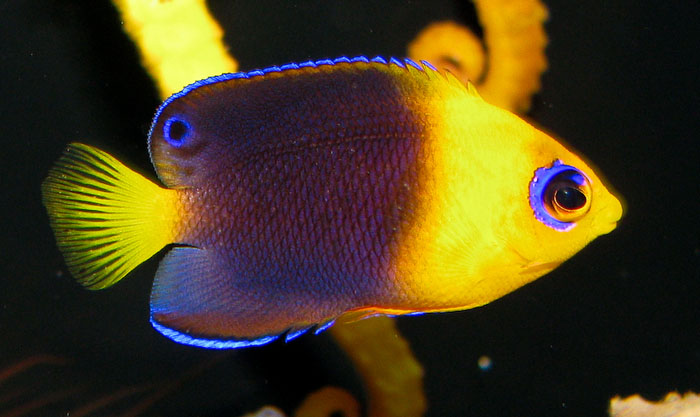
Juvenile fish such as this young Joculator angelfish cannot be expected to spawn until they reach maturity.
Some long extended courtship displays may not always conclude with successful spawning. As with people, the male reef fish is always eager to spawn, but sometimes the female is “too tired” and decides to tuck in early for the night. Other times, the pair of fish might go through the motions but not actually release any gametes in the tank. However, some other circumstances might decrease the chances of spawning. You are less likely to get spawning in a tank with lots of other fish getting in the way, either because similar looking fish are distracting the male, or if the pair strays into another fish’s territory and the couple gets bullied out of it. Some species of reef fish will interfere with the spawning of closely related species and actively try to disrupt their spawning attempts. I first saw this intervention phenomenon with a flame hawkfish that disrupted a pair of longnose hawkfish right as they were about to breach. Another time I witnessed a purple tang, Zebrasoma xanthurus, do all it could to keep a yellow tang, Z. flavescens from getting it on with a scopas tang, Z. scopas. (Both of these events are documented in the accompanying videos). If the reef fish really want to get down they will often try their best to spawn no matter what. Having a harem of one male to several females can also increase your chances for watching reef fish spawn. If a male has several females that increases his chances of getting lucky and on a good night you may witness successive spawnings between the male and each female.
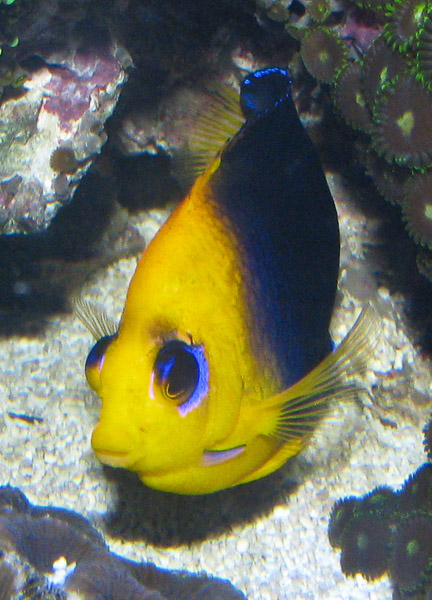
A more mature and long term captive joculator angelfish is more likely to spawn than a freshly imported one.
I am fortunate to have had a video camera with me on numerous occasions while witnessing the pelagic spawning of reef fish. A lot more can be said about how to watch for pelagic spawning, but then I would just be narrating the videos which are already embedded in this article. Watching these videos of different pelagic spawning reef fish will give you a chance to make your own notes about what to be on the lookout for if you want to catch reef fish in the act. Watching for pelagic spawning reef fish might seem somewhat voyeuristic in that we are essentially waiting for a fish’s orgasm. However, when the pelagic spawning act represents the exact moment when new life begins, it is easy to explain our fascination.
When watching the following videos, remember to look out for the triggers I’ve discussed that encourage pelagic spawning: having a twilight period of reduced lighting near the end of the day, well conditioned fish that have been heavily fed a rich food source, and of course, having a tank that is somewhat accommodating of the height requirements of pelagic spawners. To actually catch the spawning you need to provide all these details on a consistent basis and also spend a considerable amount of time watching your fish so you can recognize the difference between normal and nuptial behavior. I want to thank Matthew Wittenrich for letting me mine his wealth of experience, and I also want to thank Guin Burnard, Sanjay Joshi, Joe Yaiullo, and Kevin Kohen for spending many hours with me, waiting and watching for pelagic spawning reef fish.


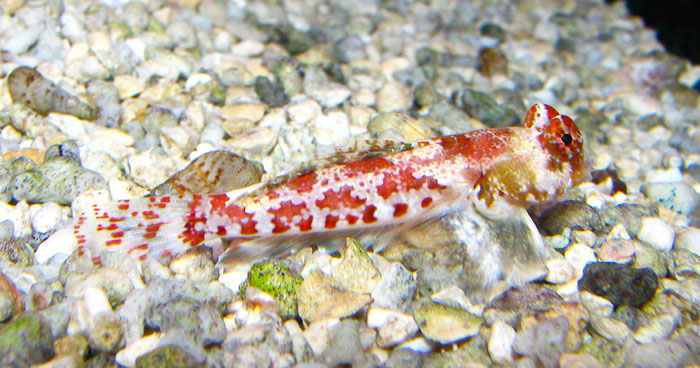
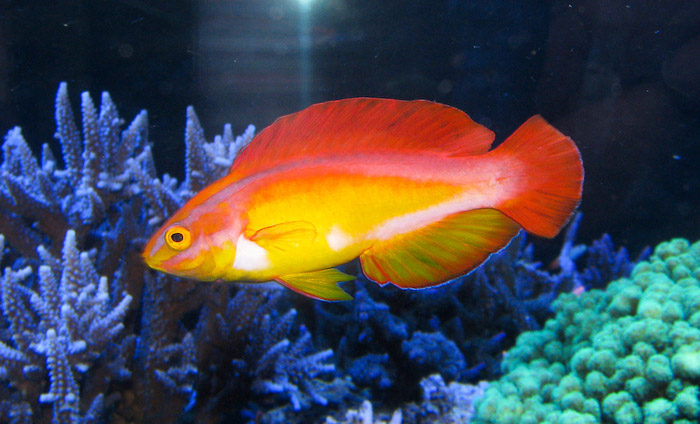

0 Comments